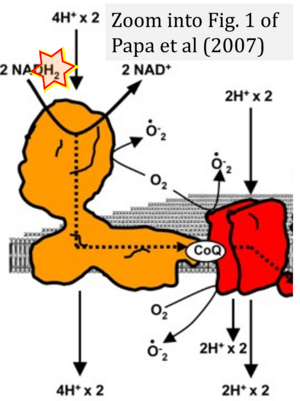Papa 2007 Springer
| Papa S, Petruzzella V, Scacco S (2007) Electron transport. Structure, redox-coupled protonmotive activity, and pathological disorders of respiratory chain Complexes. Springer, Boston, MA. In: Lajtha A, Gibson GE, Dienel GA (eds) Handbook of neurochemistry and molecular neurobiology:93–118. https://doi.org/10.1007/978-0-387-30411-3_5 |
Papa S, Petruzzella V, Scacco S (2007) Springer, Boston, MA.
Abstract: This chapter is intended to provide an overview of mitochondrial respiratory chain complexes from protein structure and functional mechanisms to their biogenesis and genetic disorders in neurological and other diseases. The general features and the electron transfer centers of the protonmotive respiratory chain is first dealt with. This section is followed by a description of the protein structure of the four redox complexes of the chain. A section is devoted to mechanism of the proton pump of complexes I, III and IV with particular emphasis to complex IV. The last two sections cover aspects of the biogenesis of the redox complexes and their genetic disorders in human pathology respectively.
• Bioblast editor: Gnaiger E
Hydrogen ion ambiguities in the electron transfer system
Communicated by Gnaiger E (2023-10-08) last update 2023-11-10
- Electron (e-) transfer linked to hydrogen ion (hydron; H+) transfer is a fundamental concept in the field of bioenergetics, critical for understanding redox-coupled energy transformations.
- However, the current literature contains inconsistencies regarding H+ formation on the negative side of bioenergetic membranes, such as the matrix side of the mitochondrial inner membrane, when NADH is oxidized during oxidative phosphorylation (OXPHOS). Ambiguities arise when examining the oxidation of NADH by respiratory Complex I or succinate by Complex II.
- Oxidation of NADH or succinate involves a two-electron transfer of 2{H++e-} to FMN or FAD, respectively. Figures indicating a single electron e- transferred from NADH or succinate lack accuracy.
- The oxidized NAD+ is distinguished from NAD indicating nicotinamide adenine dinucleotide independent of oxidation state.
- NADH + H+ → NAD+ +2{H++e-} is the oxidation half-reaction in this H+-linked electron transfer represented as 2{H++e-} (Gnaiger 2023). Putative H+ formation shown as NADH → NAD+ + H+ conflicts with chemiosmotic coupling stoichiometries between H+ translocation across the coupling membrane and electron transfer to oxygen. Ensuring clarity in this complex field is imperative to tackle the apparent ambiguity crisis and prevent confusion, particularly in light of the increasing number of interdisciplinary publications on bioenergetics concerning diagnostic and clinical applications of OXPHOS analysis.
- NADH2 does not make sense.



